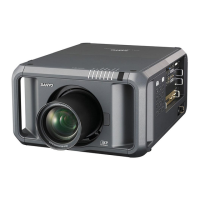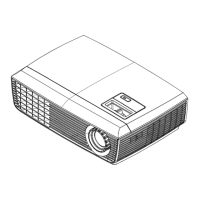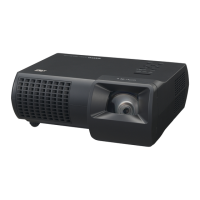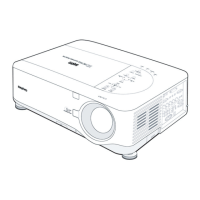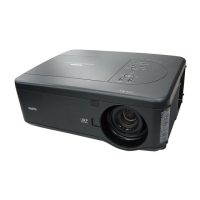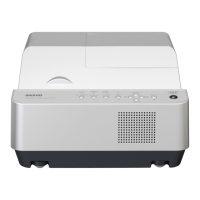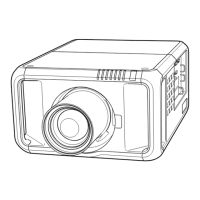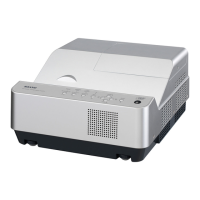Do you have a question about the Sanyo PDG-DHT8000L and is the answer not in the manual?
Supports Full HD signals for high-definition projection. Features user-changeable color wheels for brightness or color.
Ensures projector security with Key lock and PIN code lock functions to prevent unauthorized use.
Allows lens movement up, down, right, and left for easy image positioning. Zoom and focus can also be adjusted.
Guidance on proper projector positioning to ensure safe operation and prevent fire hazards.
Instructions and precautions for safely moving the projector, including carrying and transport.
Warning about hazards related to improper ceiling mounting and the need for approved kits.
Details on the AC power cord specifications and safe connection to the power outlet.
Diagram and description of all input/output terminals on the projector.
Identification and function of buttons on the projector's side control panel.
Explanation of the status indicators on the projector and their meanings.
Layout and functions of the remote control buttons.
Guidance on installing and replacing the projector lens, with safety precautions.
Instructions and diagrams for connecting the projector to a computer via various cables.
Instructions and diagrams for connecting video equipment using different cable types.
Steps for connecting the AC power cord and attaching the fixing bracket.
Step-by-step guide for powering on the projector and initial setup.
Procedure for safely turning off the projector and maintaining lamp life.
Instructions on navigating and using the projector's on-screen menu system.
Detailed explanation of how to use the remote control for various projector functions.
Guide to selecting input sources using the side control and remote control.
Automatic and manual selection of computer system settings for optimal image projection.
Function to automatically adjust fine sync, dots, and positions for computer input.
Precise adjustment of signal parameters like fine sync, total dots, and position.
Automatic detection and manual selection of video system formats (PAL, SECAM, NTSC).
Adjusting the screen size for video input signals, including zoom, full, and custom options.
Detailed settings for contrast, brightness, color, tint, sharpness, and gamma.
Function to adjust chromatic coordinates and brightness of specific display colors.
Selection of the on-screen menu language from multiple available options.
Controls lamp operation, allowing selection between 2 lamps, Lamp1, or Lamp2.
Function to display two videos simultaneously, with options for mode, size, and position.
Features like Key lock and PIN code lock to prevent unauthorized operation.
Controls the shutter function for blocking light, including protection and management settings.
Information on how the filter works, its maintenance, and replacement indicators.
Step-by-step guide for replacing the filter cartridge and resetting counters.
Overview of the lamp management function, indicators, and lamp mode control.
Instructions for replacing projection lamps, including safety precautions.
Explanation of projector status indicated by warning lights and troubleshooting steps.
Solutions for common problems encountered with the projector operation.
List of supported computer resolutions, horizontal, and vertical frequencies.
Detailed technical data including dimensions, power, interfaces, and environmental requirements.
Pin assignments for various projector connectors like VGA, USB, HDMI, and LAN.
Procedure for seamlessly overlapping images from multiple projectors using edge blending.
Steps to adjust color settings for multiple projectors to ensure color uniformity.
Supports Full HD signals for high-definition projection. Features user-changeable color wheels for brightness or color.
Ensures projector security with Key lock and PIN code lock functions to prevent unauthorized use.
Allows lens movement up, down, right, and left for easy image positioning. Zoom and focus can also be adjusted.
Guidance on proper projector positioning to ensure safe operation and prevent fire hazards.
Instructions and precautions for safely moving the projector, including carrying and transport.
Warning about hazards related to improper ceiling mounting and the need for approved kits.
Details on the AC power cord specifications and safe connection to the power outlet.
Diagram and description of all input/output terminals on the projector.
Identification and function of buttons on the projector's side control panel.
Explanation of the status indicators on the projector and their meanings.
Layout and functions of the remote control buttons.
Guidance on installing and replacing the projector lens, with safety precautions.
Instructions and diagrams for connecting the projector to a computer via various cables.
Instructions and diagrams for connecting video equipment using different cable types.
Steps for connecting the AC power cord and attaching the fixing bracket.
Step-by-step guide for powering on the projector and initial setup.
Procedure for safely turning off the projector and maintaining lamp life.
Instructions on navigating and using the projector's on-screen menu system.
Detailed explanation of how to use the remote control for various projector functions.
Guide to selecting input sources using the side control and remote control.
Automatic and manual selection of computer system settings for optimal image projection.
Function to automatically adjust fine sync, dots, and positions for computer input.
Precise adjustment of signal parameters like fine sync, total dots, and position.
Automatic detection and manual selection of video system formats (PAL, SECAM, NTSC).
Adjusting the screen size for video input signals, including zoom, full, and custom options.
Detailed settings for contrast, brightness, color, tint, sharpness, and gamma.
Function to adjust chromatic coordinates and brightness of specific display colors.
Selection of the on-screen menu language from multiple available options.
Controls lamp operation, allowing selection between 2 lamps, Lamp1, or Lamp2.
Function to display two videos simultaneously, with options for mode, size, and position.
Features like Key lock and PIN code lock to prevent unauthorized operation.
Controls the shutter function for blocking light, including protection and management settings.
Information on how the filter works, its maintenance, and replacement indicators.
Step-by-step guide for replacing the filter cartridge and resetting counters.
Overview of the lamp management function, indicators, and lamp mode control.
Instructions for replacing projection lamps, including safety precautions.
Explanation of projector status indicated by warning lights and troubleshooting steps.
Solutions for common problems encountered with the projector operation.
List of supported computer resolutions, horizontal, and vertical frequencies.
Detailed technical data including dimensions, power, interfaces, and environmental requirements.
Pin assignments for various projector connectors like VGA, USB, HDMI, and LAN.
Procedure for seamlessly overlapping images from multiple projectors using edge blending.
Steps to adjust color settings for multiple projectors to ensure color uniformity.
| Heat dissipation | 3286 BTU/h |
|---|---|
| Projection distance | - m |
| Projection technology | DLP |
| Screen size compatibility | - \ |
| Projector native resolution | WUXGA (1920x1200) |
| Resolution | 2073600 pixels |
| Aspect ratio | 16:9 |
| RS-232 ports | 1 |
| Dimensions (WxDxH) | 398.78 x 523.24 x 241.3 mm |
| Power requirements | 100 - 240V |
| Focal length range | - mm |
| Lamp type | UHP |
| Lamp power | 330 W |
| Light source type | Lamp |
| Service life of light source | - h |
| Service life of light source (economic mode) | 3000 h |
| Noise level | 35 dB |
| Dot clock scanning frequency | 230 MHz |
| Built-in speaker(s) | No |
| Serial interface type | RS-232 |
| USB 2.0 ports quantity | USB 2.0 ports have a data transmission speed of 480 Mbps, and are backwards compatible with USB 1.1 ports. You can connect all kinds of peripheral devices to them. |
| Power consumption (standby) | - W |
| Power consumption (typical) | 963 W |
| Display diagonal | 0.95 \ |
| Placement | Ceiling |
| Weight | 19595.19 g |
|---|

